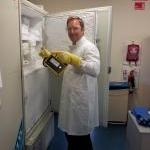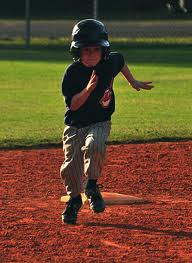Main Menu
Latest Blog Entry
User login
Physical Literacy/ Athletic Development: Vern Gambetta
“Paper is 1 dimensional; humans live and breathe in 3 dimensions”.
Vern Gambetta delivered the first lecture of GAIN V on the importance of Physical Literacy and how it underpins everything else we do.
(I know I have reviewed this backwards,but it also acts as a summary of everything I learnt this year).
Gambetta’s lecture emphasised the fact that the Human body is a self organising system that is capable of amazing things: our training should reflect that, not inhibit it.
 In the rush to use Sports Science, the most important element is the Human element. Hence the quote above.
In the rush to use Sports Science, the most important element is the Human element. Hence the quote above.
The workout starts with the Warm Up and this should include “Linking, synching and connecting movements”… or you could sit on a foam roller.
The training must include Force Reduction and Proprioception, as well as Force Production.
Putting Physical Literacy into practice.
Gambetta expanded the Physical Literacy analogy by putting this sequence together:
- Physical Literacy (your ABCs)
- Physical Competence (A sentence)
- Specific Sport Skill / Technique (A paragraph)
- Sports Performance (A Novel)
No one tries to write a novel before learning how to read, but are Coaches and Parents trying to get their kids and athletes to do things without the correct tools?
“Sports reflect society”. Kids have less opportunity for informal play and experimentation. PE classes are sports classes, rather than physical education.
We need “Mandatory DAILY physical education, taught by trained EDUCATORS.”
 Another problem is the lack of sleep that teenagers are getting. Constantly wired into their screen devices, or staying up late to catch up on studies, means they don’t get enough REM sleep for development.
Another problem is the lack of sleep that teenagers are getting. Constantly wired into their screen devices, or staying up late to catch up on studies, means they don’t get enough REM sleep for development.
Kids are not miniature adults
Too much training + too formal= not enough play
 Kids must be able to play. This leads to better all around development: Cognitively; physically and socially. (That doesn’t mean adult organised play based on mini versions of team sports).
Kids must be able to play. This leads to better all around development: Cognitively; physically and socially. (That doesn’t mean adult organised play based on mini versions of team sports).
Kids grow upwards first, then outwards. So trying to change that sequence through loading and lifting is damaging.
(Dave Ellis also made that point when showing different frames and sizes of NBA players).
These areas are crucial for development and must be included in the overall training plan:
- Rhythmic awareness (timing, use music).
- Directional awareness (all directions, up down, left and right, forward/ backward).
- Visual awareness (tracking, balls, people, objects, use balloons early on).
- Spatial awareness (where you are in relation to other players. Lining up in formations helps this).
- Tactile awareness (the ground, other people. Judo, wrestling help here).
- Auditory awareness (footfalls, problem of loud music in the gym).
- Body awareness (hand in relation to foot, hand to hand, hand to head, head to foot etc).
- Temporal awareness (jumps, change of direction, catching).
Locomotion is key to Athletic Development
 None of these qualities operate in isolation. Instead, they sequence and operate together. The gait cycle is fundamental in this.
None of these qualities operate in isolation. Instead, they sequence and operate together. The gait cycle is fundamental in this.
(I did talk to Vern about training blind athletes who have not had the opportunity to develop this gait cycle: it inhibits everything they are trying to learn and do later on).
Movement is a series of dynamic postures. Working on static posture such as pilates is fine, but we must look to progress and sequence these postures.
(Posture was mentioned in one form or another in every lecture).
Vern then discusses Assymetry vs Symmetry in posture, saying that the body is assymetrical and we shouldn’t get too hung up on this.
(I disagreed to some extent, working with developmental athletes we are continually trying to balance front/ back and left/ right. Especially with sports like cricket who do too much assymetrical work and the kids are getting injured).
“Skill ’em not Drill ’em”
Another common theme in GAIN, was the emphasis on creating skills through challenging environments and scenarios. This compares to endless drill practice, where the kids get good at drills, but with zero transfer to the sport (ladders anyone?).
Vern also used the example of tyre flipping as part of Strongman training that encourages the use of slow movements. Much slower than the demands of the sport. (Subsequent discussions have agreed on a time and place for this type of training, but not to exclusion of other things).
One of Vern’s mantras is to “Keep competence development one step ahead of skill development”. That means the athlete’s phsycial skills are developed before their technical skills.
(I have seen kids being taught triple jump who can not stand on one leg, can not do a body weight squat with control and can not stick a 2 foot landing).
In young kids, running actions are quite good. Giving the kids games and races that encourage them to run around are better than doing run drills. Changing surfaces, taking off shoes (sometimes), running up and down inclines all help.
Lessons Learnt
 For those of you (if there are any) who have read this series of blogs, you may think have gone into too much detail. I haven’t: I have just scratched the surface.
For those of you (if there are any) who have read this series of blogs, you may think have gone into too much detail. I haven’t: I have just scratched the surface.
Here are some of the other thoughts gained from informal conversations at meal times.
- Everything is everything (Tracy Fober quote) do not work in isolation.
- Interdisciplinary conversations and meetings are essential.
- Sharing ideas gets away from silo mentalities.
- There is a continuum from child development to professional athlete. Nearly every coach or lecturer mentioned posture for example. What affects the PE teacher is also relevant to the physiotherapist, track coach, strength coach and football coach.
- Coaching is essential, drilling is mindless.
- Testing or random number gathering? Data and information is important, but it must be relevant and not get in the way of training.
- Don’t move up a run distance until you can at least run a decent time over a shorter one. Do you run marathons or endure them? (Randy Ballard!)
Thanks again to roomie Andy Stone for sharing his wrestling and PE ideas and being a good training partner.
Thanks to Vern Gambetta and all the lecturers for their insights and sharing. They are all very approachable and they are all there to learn too.
Thanks to all the attendees who also shared and imparted their wisdom and experiences. The whole environment was one of learning and sharing by consumate professionals.
Most importantly I have had time to take an Operational Pause over the summer and reflect on my current practices and training programmes. By trying things out and applying them I am able to consider how they fit in.
Further reading:
Client Testimonials
 David Lloyd Tennis Academy
David Lloyd Tennis Academy
James is much liked and respected by all the players both because of his wide knowledge of tennis specific fitness and his ability to communicate the content.
More


Comments
[…] Education and Athletic Development have many similar aspects. Without a sound health basis, physical literacy and role models in school teachers and parents, our children will never become engaged in […]